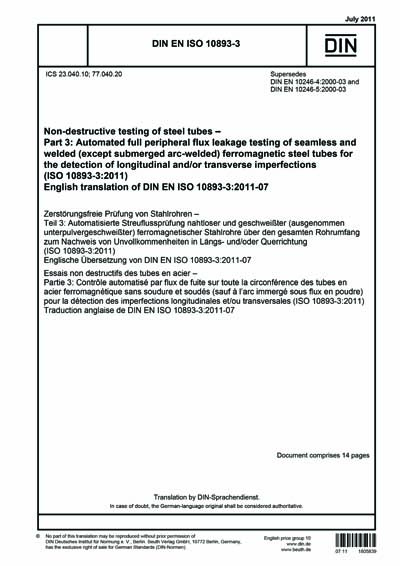Historical
DIN EN ISO 10893-3:2011
Non-destructive testing of steel tubes - Part 3: Automated full peripheral flux leakage testing of seamless and welded (except submerged arc-welded) ferromagnetic steel tubes for the detection of longitudinal and/or transverse imperfections (ISO 10893-3:2011); German version EN ISO 10893-3:2011
This part of ISO 10893 specifies requirements for automated full peripheral magnetic flux leakage testing of seamless and welded ferromagnetic steel tubes, with the exception of submerged arc-welded (SAW) tubes, for the detection of imperfections.*The DIN EN ISO 10893-1 to -12 standard series summarizes the non-destructive tests (abbreviated NDT) for steel tubes. This standard series replaces the previous DIN EN 10264-1 to -18 standard series. The consensus reached at an international level on carrying out non-destructive testing on steel tubes is another step towards worldwide harmonization on the international pipe market. Non-destructive tests represent, in addition to destructive mechanical tests, the most important elements of quality assurance for steel tubes. They are widely used, often during production, for quality assurance. Non-destructive tests are primarily used on pressure-retaining pipes for chemical, petrochemical and power station industries. They can also be agreed on with regard to tests of parts of the body (limited to the weld seam or pipe ends) or with regard to testing the whole body. The most important methods are electromagnetic testing (see Parts 1 to 3), radiographic testing (see Parts 6 and 7), and ultrasonic testing (see Parts 8 to 12). Ultrasonic testing is the usual test method for all tube thicknesses and tube diameters; it is the preferred test method especially for thick-walled tubes. Increased test speeds can be achieved with the electromagnetic methods (eddy current method and magnetic leakage-flux method) where the eddy current method is limited topipes with smaller diameters and the magnetic leakage-flux method to ferromagnetic pipes. Radiographic testing of weld seams with X-rays has been established for testing safety-relevant tubes (for example, in nuclear technology). In addition to the three standardized methods, dye penetration testing (see Part 4) and the magnetic particle inspection (see Part 5), which are used to detect surface imperfections shall be mentioned. After agreement, the non-destructive tests of EN ISO 10893 can be carried out on hollow sections which are used in steel construction. The Iron and Steel Standards Committee (FES), Subcommittee NA 021-00-09-06 UA "Zerstörungsfreie Prüfung von Rohren" ("Non-destructive testing of pipes") is responsible for this standard series.
Content Provider
Deutsches Institut für Normung [din]






